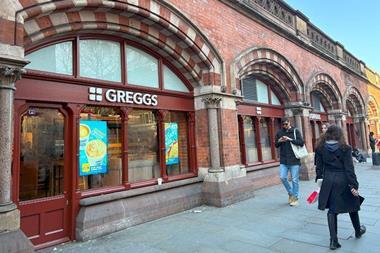Mark Irvine-Fortescue, who has recently joined Stifel from Panmure Gordon, writes that in a lacklustre operating environment, pub and restaurant equity performance will be driven by companies’ ability to flex balance sheets, as the US investment bank relaunches coverage of the UK leisure sector. Features his thoughts on The Restaurant Group, Young’s and Mitchells & Butlers, among others
Key points
With weak investor sentiment towards Travel and Gambling, we commence coverage with Pubs and Restaurants at a time when the sector presents value, GARP, yield and transformation opportunities for investors. We are social animals and eating and drinking out of the home has proved resilient to whatever the economic and political backdrop presents. We think this remains the case in today’s digital age, i.e. difficult to replicate online, with home delivery not being a genuine substitute in our ‘experience society’. But the ubiquity of technology does reflect evolving consumer trends and operators also need to evolve to stay relevant. We expect steady overall demand-side dynamics, but with emphasis on quality, value, consistency, premiumisation, convenience and experience.
Our coverage spans branded pubs and restaurants, wet-led pubs and brewing, and F&B units in travel hubs. We assume a relatively high level of reader familiarity with the sector; this report focuses squarely on key sector themes and investment debates for each company. The big picture backdrop is solid. Our supply-side data-led view suggests the operating environment still favours wet-led pubs over restaurants.
Buy - The Restaurant Group (170p TP)
The shares appear oversold given the transformational nature of the Wagamama deal, and a concerted effort to ‘manage down’ the Leisure business – which shareholders are currently getting for free. Transformational deals don’t always come at an ideal time or price, as here. But this deal unequivocally brings positive strategic change, or ‘kaizen’ in Wagamama parlance. Stabilisation of Leisure, problem-free integration and execution on synergies should be enough to drive a re-rating, after which attention can move to the more exciting multi-channel growth prospects. Our new analysis gives us confidence that TRG can do just that.
Buy - Fuller’s (1250p TP)
We expect an earnings upgrade cycle to drive share price momentum as surplus capital is deployed following the exit of brewing. With a market capitalisation close to Marston’s, and a supportive industry backdrop, we think Fuller’s should be appearing on the radar of more investors. Including an expected special dividend, our 1250p target price implies 25% TSR.
Buy – Young’s (TP 1800p)
Young’s has some of the more promising growth prospects in the sector as the balance sheet is put to work. This is no sleepy family business, and gold standard credentials make it a good defensive UK domestic play. The share price does not give credit for Young’s latest value-enhancing deal, let alone any future M&A. With a market capitalisation bigger than Marston’s we think Young’s should be appearing on the radar of more investors.
Sell - J D Wetherspoon (1100p TP)
JDW is trading at peak valuation on peak earnings, giving cause for share price concern when there are underlying forecast downgrades and ROCE is at 10 year lows. Furthermore, share buybacks, for so long propping up EPS, seem to be off the agenda. We think this will refocus investor attention on longterm margin erosion and profits going backwards this year. We are fans of the business, but not of the shares at this premium valuation. Our forecasts are below consensus and our 1100p target price assumes a de-rating to more comfortable levels.
Hold – Greene King (680p TP)
Profit expectations have stabilised after four years of downgrades, and investors have been quick to capitalise on the value opportunity. With asset backing and a secure dividend, Greene King has become the consensual pub sector play on this theme, with shares increasing more than 30% from summer 2018 lows. Ongoing refinance benefits have been increasingly discounted, and we think a positive surprise is needed to drive share price outperformance from here. With a new CEO, that cannot be ruled out, but our base case is for no major pivot on strategy or capital structure.
Hold – SSP Group (700p TP)
Momentum in the business is strong and the industry backdrop remains supportive, underpinning 10% EPS growth for the next three years. We also bake £150m p.a. special dividends into our forecasts, driving 17% TSR. Strong execution and a record of ‘beat and raise’ helps justify the high valuation (25x FY19E PE), but leaves little room for disappointment as SSP transitions to a new CEO.
Hold – Marston’s (100p TP)
A P/E and dividend yield both of ~7 suggests value or distress. But Marston’s is neither really, as high leverage comes with freehold backing. The new era of capex conservation provides comfort over dividend cash cover, but will not help the top line, and fixed debt obligations means de-leveraging will be slow.
Hold – Mitchells & Butlers (290p TP)
A perennial story of promise, for us M&B remains in the special situation camp. Estate investment is helping top line recovery but the portfolio is skewed towards the toughest parts of the market, as casual dining overcapacity only adjusts slowly. With little profit growth and no dividend in sight attention drifts, as ever, to property backing. The discount to NAV is noteworthy, but not especially elevated relative to history. We struggle for a catalyst to take an active stance and resume coverage with a Hold rating.
Sanguine on the UK Consumer
We expect consumers to remain disciplined toward discretionary spending, sustaining the current level of eating and drinking out of the home – which remains fairly resilient compared to the wider retail bricks and mortar performance. As much as ever consumer emphasis will be on quality, value, service, convenience and experience, with successful operators innovating and evolving with trends such as healthier food options, drinking less but better (premiumisation) and delivery. A disorderly Brexit may weaken consumer confidence and the propensity of consumers and company Boards to spend, with inflationary pressure from GBP weakness. But the GFC showed how pubs in particular are pretty resilient to the economic cycle, with very few negative LFL showings across our coverage even in the dark days of 2008-09.
Excess Supply is Slowing Leaving the Market
In our view, supply-side dynamics are probably the most important driver of prospects for pub and restaurant operators. Unsurprisingly, the data leads us to the view that supply is broadly supportive for drink-oriented operators (Young’s, Fuller’s, Marston’s, JDW). Food-led supply shrinkage has been slow but with casual dining closures recently gathering pace. We doubt whether a rebasing as severe as the 20%+ seen in the wet-led sector is needed to stabile the casual dining market, given positive developments emerging in tenant/landlord power shifts and growth channels like delivery and food-to-go.
We see four major considerations that will determine the shape of market supply over the next few years:
1. Delivery and food-to-go. One reason supply has been relatively sticky is consumers’ increasing desire for convenience, supporting strong growth in delivery, travel and ‘food-to-go’ channels. Many operators have looked to tap into this trend and boost their top line from existing premises, although we envisage a big difference between those with the right concept/brand/systems/locations to sustain profitable growth from delivery, and a long tail without, as well as some where delivery has a negative perception on the brand. Whilst some Pub cos are positive about delivery trials (Mitchells & Butlers believes up to 400 of its branded pub/restaurants could lend themselves to delivery in time), we expect delivery to be more significant for casual dining operators. In our coverage TRG is most exposed to delivery trends. The other sub-channel that is seeing robust growth is the ‘food-to-go’ market, which includes national brands like Greggs, Subway and Pret, This sector is in rude health and predicted to grow at 8% CAGR to £7.7bn by 2022
2. Company Voluntary Arrangements. The last 12 months has seen a string of casual dining chains flagging financial strain, site closures and/or slowing expansion – often through company voluntary arrangements (CVA)s. This protection enables struggling operators to compromise with creditors which typically means agreeing lower rents from landlords rather than closing units. CVAs are understandably controversial given the uneven playing field it leaves which arguably affects strategic behaviour, sustaining discounting and slowing the exit rate of excess supply. These closures (c400) may garner lots of press coverage but only actually represent about 2% of the total restaurant market, although there will be smaller operators that we are unable to track. Recent sector trading has remained tough and we would be surprised if there wasn’t still a significant number of sites across the sector with questionable viability.
3. Tenant/landlord power shift. The prevalence of CVAs has helped highlight secular trends like declining footfall in shopping centres and high streets and differences in the tax burden between bricks and mortar and online operators. In this context the traditional tenant/landlord model of inflexible, upward only long-term leases seems ripe for change at a time when IFRS 16 is making the liabilities for tenants much more visible to stakeholders. The publicity around CVAs may well be the catalyst for shifting the balance of power from landlords to tenants given an increasing acceptance by banks and investors to realign landlord returns. Over time lower rents will also feed into lower business rates. The emergence of virtual restaurants and dark kitchens in low rent locations also aligns with this trend.
4. Promotional activity remains elevated with persistent menu discounting across many branded restaurant operators. Promotions have become entrenched in customer expectations so the road back to full price could be a long one. Margin pressure and high operational gearing might be expected to put off new entrants, but often this does not seem to be the case.
Balance Sheet Flex to Drive Growth
Our demand and supply-side analysis above points to a low organic sales growth environment which, combined with cost headwinds, translates to a low/no organic profit growth environment. The exception is SSP where mid-single digit sales growth and steady margin expansion translates into double-digit EPS growth. For the rest of our coverage profit growth, and shareholder value, will be driven more by companies’ ability to flex balance sheets. This ranges from bolt-on corporate activity (Fuller’s, Young’s, SSP) to full on M&A (TRG), special dividends (Fuller’s, SSP), share buybacks (JDW no longer?) and capital structure optimisation (Greene King, Marston’s, Mitchells & Butlers). We run through the key financial drivers that underpin those prospects.
- To read the full report and individual operator notes, click here
Precis
Analysts Corner: Irvine-Fortescue on UK pubs & restaurants
Mark Irvine-Fortescue, who has recently joined Stifel from Panmure Gordon, writes that in a lacklustre operating environment, pub and restaurant equity performance will be driven by companies’ ability to flex balance sheets, as the US investment bank relaunches coverage of the UK leisure sector. Features his thoughts on The Restaurant Group, Young’s and Mitchells & Butlers, among others











































